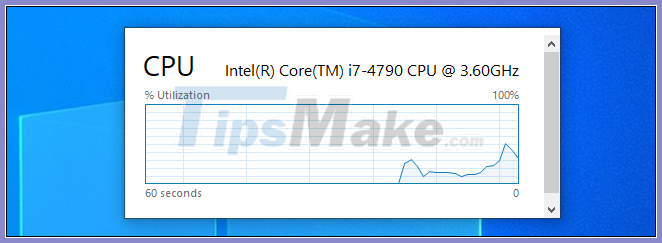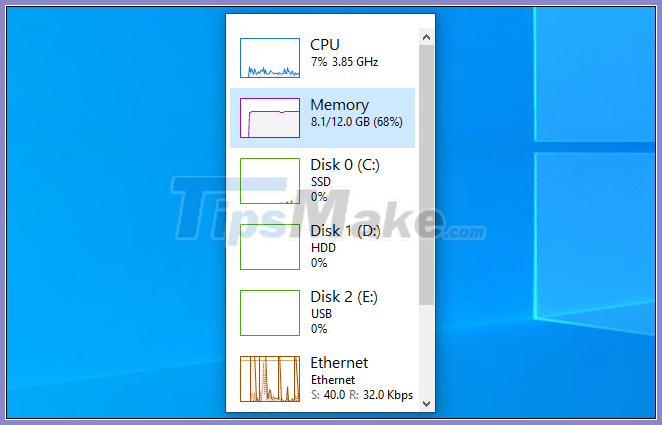How to show Windows 10's hidden floating performance panel
Want to see up-to-date resource usage statistics directly from your system's CPU, memory, drives, network or GPU? Windows 10 has several hidden built-in performance monitors that might help. You can even always have Windows show FPS at the top.
There are two ways to do this: You can either use Task Manager or overlay the Xbox Game Bar. Both tools have some easy-to-miss performance panels that can be detached from the tool itself and will appear as a small floating overlay, always on top of other running apps. The article will show you both methods here.
Activate the Performance window of the Task Manager
Windows 10's Task Manager comes with performance stats that have been added from within Windows 8. You can separate these statistics from the Task Manager window.
To find them, open Task Manager by pressing Windows + Shift + Esc or right-clicking on the taskbar and selecting Task Manager.
Click Options> Always on Top if you want the overlay window to always appear on top of your other application windows.

Click the Performance tab at the top of the window. If you don't see it, first click More Details at the bottom.
Select the performance chart you want to see in the sidebar. You'll see options for your computer's CPU, memory, storage devices (including SSDs, hard drives, and USB devices), network connectivity (wired Ethernet and WiFi), GPU (graphics processor ).
To show only one performance chart, double-click anywhere on the chart in the right panel. You can also right-click on the chart and choose Graph Summary View .

You can resize the window to make the window smaller, and you can also click and drag anywhere inside it to position it where you want on the screen.
 Position the chart as you like
Position the chart as you like
To re-maximize the Task Manager window, simply double-click inside it or right-click and deselect Graph Summary View .
If you want to change to a different graph - for example, to change from CPU to GPU usage statistics - double click on the chart window, select another graph in the sidebar and double click on chart one Again.
By the way, you can also double-click anywhere on the left panel to see it in a smaller floating window. It's a great way to keep track of multiple resource stats at the same time.
 View control panel in smaller window
View control panel in smaller window
Pin the Game Bar's performance panel to the screen
Windows 10 Game Bar is an integrated overlay with all sorts of tools useful for gamers (and non-gamers), including performance graphs. This floating window is commonly found in the main Game Bar overlay. However, you can 'pin' it to your desktop and have it appear in all other windows - desktop applications and PC games are the same.
To find it, open the Xbox Game Bar overlay by pressing Windows + G .
If the Game Bar doesn't appear, go to Settings> Gaming> Xbox Game Bar . Make sure Game Bar is enabled and check its keyboard shortcut here. You may have disabled the Game Bar or previously selected a custom shortcut to open it.
 Make sure Game Bar is enabled
Make sure Game Bar is enabled
Find the Performance window , near the bottom left corner of the Game Bar overlay screen by default. If you don't see it, click the Performance button on the Game Bar menu at the top of the screen to display it.

Click the Pin button above the small Performance window .
Now, it will appear even if you close the Game Bar interface. Click anywhere in the background of the overlay or press Windows + G again to close the Xbox Game Bar overlay.
You can hover over the Performance window and click the arrow to maximize the window (show the graph) or minimize it (show resource usage statistics on the side of the window only).
You can also click an option on the left side - CPU, GPU, RAM or FPS - to bring up that graph. To start viewing FPS stats, click on the FPS option and follow the instructions in the window. You will be asked to click the Request Access button and then restart your PC.
To further customize, open the Game Bar interface by pressing Windows + G . Here, you can drag the title bar of the window to position it on the screen. You can only move the floating window from the Game Bar overlay.
You can also click the Performance Options settings button at the top of the Performance window in the overlay to get more settings. It is located to the left of the Pin button .
Here, you can control the accent color (green by default), make the overlay with a transparent background, choose which metrics (CPU, GPU, RAM and FPS) are displayed, and choose which side of the door window in which the chart appears.
If you're displaying performance graphs above a full-screen game, you may want to enable transparency for better integration into your game interface.

To hide the window, reopen the Game Bar interface ( Windows + G ) and click the pin icon on the Performance window . It will be unpinned and will only show up when you open the Game Bar interface.
You should read it
- How to monitor GPU performance in Task Manager of Windows 10
- 35 tools, scripts and plugins to build HTML Table
- Table fans and box fans, which is the smart choice?
- Should a table drill be used?
- Table operations in Word
- How to fix table errors in Word overflow
- Instructions for inserting table captions in Word
- What kind of drilling machine is best?
May be interested
- Adjust for Control Panel interface
 in this article we will show you a small interesting adjustment to control panel.
in this article we will show you a small interesting adjustment to control panel. - Instructions for using Windows Control Panel effectively
 in this article, we will show you how to find the best tools in windows for you to improve your computer.
in this article, we will show you how to find the best tools in windows for you to improve your computer. - How to show hidden files in USB
 usb data being pressed or lost is a problem that users often encounter. so how to show hidden files in usb, memory card? the following article of thuthuatphanmem.vn will guide you how to show hidden files in usb, memory cards in detail.
usb data being pressed or lost is a problem that users often encounter. so how to show hidden files in usb, memory card? the following article of thuthuatphanmem.vn will guide you how to show hidden files in usb, memory cards in detail. - How to Show Hidden Files in Windows 7
 windows 7 hides important folders and files in order to keep users from modifying or deleting their files and subsequently damaging their systems. windows 7 does not show hidden files by default. for example, the pagefile.sys file is a...
windows 7 hides important folders and files in order to keep users from modifying or deleting their files and subsequently damaging their systems. windows 7 does not show hidden files by default. for example, the pagefile.sys file is a... - How to add Services to Control Panel in Windows 7, 8 and 10
 service is a type of application that runs in the background without a user interface, similar to the unix daemon process. services are not in control panel by default, but you can add it if you want.
service is a type of application that runs in the background without a user interface, similar to the unix daemon process. services are not in control panel by default, but you can add it if you want. - How to put Control Panel in the right-click menu on Windows 10
 there are several ways to open control panel in windows 10, such as from the start menu or windows search. this article from tipsmake will show you how to access it faster.
there are several ways to open control panel in windows 10, such as from the start menu or windows search. this article from tipsmake will show you how to access it faster. - Restore hidden folders in Windows when infected
 in many cases it is often the virus that attacks the system's hidden folders that cannot be displayed even if you have enabled the 'show hidden files and folders' option in folder options. some of the following methods will help solve this problem.
in many cases it is often the virus that attacks the system's hidden folders that cannot be displayed even if you have enabled the 'show hidden files and folders' option in folder options. some of the following methods will help solve this problem. - Instructions on how to show hidden files in USB correctly
 you want to open a hidden file in usb, but when connecting to the computer, the file is suddenly hidden and not displayed, hindering your work. don't worry, be greedy
you want to open a hidden file in usb, but when connecting to the computer, the file is suddenly hidden and not displayed, hindering your work. don't worry, be greedy - How to open Control Panel on Windows 11
 when you want to change settings in windows 11, the first place most people think of is the settings app. however, the control panel still plays an extremely important role in many of the configuration tasks you need on a new operating system.
when you want to change settings in windows 11, the first place most people think of is the settings app. however, the control panel still plays an extremely important role in many of the configuration tasks you need on a new operating system. - Instructions for using hidden icons on Mac keyboard
 on mac keyboards are also integrated icons, special characters. however, these icons are hidden so very few mac users know. in the article below, network administrator will show you some ways to use these icons on mac.
on mac keyboards are also integrated icons, special characters. however, these icons are hidden so very few mac users know. in the article below, network administrator will show you some ways to use these icons on mac.









 9 ways to open Computer Management in Windows 10
9 ways to open Computer Management in Windows 10 How to set a separate password for each app in Windows 10
How to set a separate password for each app in Windows 10 How to manage a huge WinSxS folder in Windows 10
How to manage a huge WinSxS folder in Windows 10 How to change regional settings on Windows 10
How to change regional settings on Windows 10 How to generate a system performance report in Windows 10
How to generate a system performance report in Windows 10 6 things to do after installing Windows 10
6 things to do after installing Windows 10